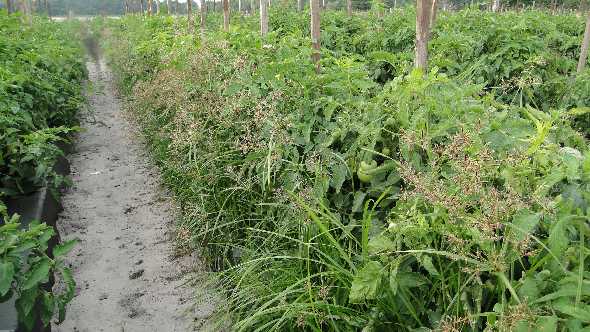Florida Farmers Fighting to Find Their Way out of the Weeds
Weeds, especially in Florida, are a constant headache for growers. In a recent survey sent to Florida Grower® magazine readers, the question was posed: What are the top three most problematic weeds on your farm? One grower responded, “Every weed on the planet.”

Purple nutsedge can overwhelm plasticulture crops if an integrated pest management program is not followed.
Photo by Frank Giles
While that might be a bit exaggerated, weeds are a constant and growing challenge in specialty crops, especially in the absence methyl bromide. And, the challenge is growing beyond Florida driven on increasing cases of herbicide resistance.
Glyphosate Resistance on the Move
Resistance to glyphosate is spreading throughout the country. This is mainly due to the usage of the transgenic crops, 86% of which have built-in tolerance to the herbicide. One monster of the resistance picture, particularly in the Southeast, is Palmer amaranth. The weed can grow up to 2 to 3 inches per day, quickly reaching heights of 8 feet or better. A single plant can produce millions of seed per season.
“Resistant weed species have been documented in Florida specialty crops,” says Peter Dittmar, an Assistant Professor with the UF/IFAS Horticultural Sciences Department. “We have seen resistance to glyphosate and ALS herbicides in the northern and north central parts of Florida. Growers in southern parts of the state should be aware of it appearing in their fields.”
According to the International Survey of Herbicide Resistant Weeds, Florida only has eight documented weed species that are resistant to herbicides. While no where near the 24 resistant species found in Arkansas, the state is a cautionary example of why resistance management is important.
University of Arkansas Professor Jason Norsworthy told CropLife® magazine just how devastating resistance has been in the state, particularly with Palmer amaranth.
“In the mid-1990s, growers in Arkansas were seeing widespread ALS resistance in Palmer amaranth,” says Norsworthy. “But then, Roundup Ready crops came along, and by 1999, virtually the entire state had adopted these for their fields. This meant everyone was spraying nothing but glyphosate year-after-year to control weeds.”
By the early 2000s, he says, glyphosate was no longer proving effective as a lone weed control herbicide, so Arkansas growers began employing PPO-inhibitors into the mix. This worked for a few years.
“Then in 2015, the wheels came off the wagon,” says Norsworthy. “That’s when PPO-resistant Palmer amaranth showed up. Now, I have story after story in Arkansas of farmers who are no longer farming and bankrupt because of resistant weeds.”
In all, he estimates approximately 25% of growers in the state have stopped farming over the past decade because of resistant weeds.
Florida Weed Foes
Regardless of crop and location, Dittmar says purple and yellow nutsedge rules as most problematic in specialty crop fields. Because crops are grown year-round and practices vary greatly, he says what may be a problem weed in one crop might be controlled easily in others. But, in general, he puts nutsedges on top, followed by black medic, parthenium ragweed, cocklebur, and common purslane.
In the Florida survey, growers scored Palmar amaranth, lambsquarters, and Spanish needle high as problematic weeds. But many other weed species were mentioned in the survey underscoring the uniquely challenging environment for weeds in the state.
Control Factors
According to a 2017 CAST Issue Paper titled “Crop Protection Contributions toward Agricultural Productivity,” there has not been a herbicide with a novel mode of action (MOA) introduced in the field crop marketplace in more than 30 years. With the introduction of Roundup Ready crops in the mid-1990s, there was not much demand for new MOAs because glyphosate worked so well in controlling weeds in the major row crops.
“Specialty crops are dependent on new MOAs being developed in agronomic crops and then over time being registered for specialty crops,” Dittmar says. “Agronomic crops weed management has focused on gene traits for herbicide tolerance, so a new MOA is not in the pipeline.”
Dittmar says UF/IFAS is working with Syngenta to expand the Reflex (fomesafen) label to include certain cucurbit crops, which would help provide broadleaf and grass control, along with nutsedge suppression. Dow AgroSciences is seeking to expand the Stinger (clopyralid) and GoalTender (oxyfluorfen) labels in cole crops, which would be important for broadleaf weed control.
FMC now has a label for Spartan FL 4F (sulfentrazone) for several Florida crops including sugarcane, strawberries, tomatoes, blueberries, grapes, lemons, and oranges.
“It controls a range of broadleaf weeds, but it also is effective on yellow nutsedge,” says Nathan Boyd, an Associate Professor with UF/IFAS. “This is a huge advantage for us because we don’t have many herbicides that can control nutsedge in vegetable crops.”
Then there is always cultural practices to manage weeds including hand labor, but that is an expensive proposition. A good fallow program has proven to have a big impact on weed populations. According to Boyd, a good program would include a burndown herbicide application with a product like glyphosate to kill weeds already present. Then stimulate another flush with cultivation followed by another herbicide application. He recommends applying glyphosate when weeds have reached their peak germination or before they flower or go to seed. That typically occurs when the weeds are in the 3- to 4-inches range.










